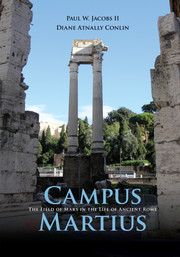Book contents
- Frontmatter
- Contents
- Illustrations
- Acknowledgments
- Maps
- Introduction: “This Place Was Holiest of All”
- Chapter One “The Size of the Plain Is Remarkable”: Defining the Limits of the Campus Martius in Time and Space
- Chapter Two Gathering Troops in the War God's Field
- Chapter Three “Very Costly Temples”: The Campus Martius and Republican Temple Construction
- Chapter Four “Chariot Races,” “Three Theatres,” “An Amphitheatre,” and More: Entertainment in the Campus Martius
- Chapter Five “Colonnades about It in Very Great Numbers”: The Porticoes of the Campus Martius
- Chapter Six Between the Aqua Virgo and the Tiber: Water and the Field of Mars
- Chapter Seven “A Zeal for Buildings”: Reshaping of the Space by the Emperors
- Conclusion: “The Rest of the City a Mere Accessory”
- Appendix A Chronology of Development in the Campus Martius to the Early Fourth Century c.e.
- Appendix B Glossary of Architectural Terms
- Notes
- Selected Bibliography
- Index
- Plate Section
Conclusion: “The Rest of the City a Mere Accessory”
Published online by Cambridge University Press: 18 December 2014
- Frontmatter
- Contents
- Illustrations
- Acknowledgments
- Maps
- Introduction: “This Place Was Holiest of All”
- Chapter One “The Size of the Plain Is Remarkable”: Defining the Limits of the Campus Martius in Time and Space
- Chapter Two Gathering Troops in the War God's Field
- Chapter Three “Very Costly Temples”: The Campus Martius and Republican Temple Construction
- Chapter Four “Chariot Races,” “Three Theatres,” “An Amphitheatre,” and More: Entertainment in the Campus Martius
- Chapter Five “Colonnades about It in Very Great Numbers”: The Porticoes of the Campus Martius
- Chapter Six Between the Aqua Virgo and the Tiber: Water and the Field of Mars
- Chapter Seven “A Zeal for Buildings”: Reshaping of the Space by the Emperors
- Conclusion: “The Rest of the City a Mere Accessory”
- Appendix A Chronology of Development in the Campus Martius to the Early Fourth Century c.e.
- Appendix B Glossary of Architectural Terms
- Notes
- Selected Bibliography
- Index
- Plate Section
Summary
From the time of its mythical founding in the mid-eighth century b.c.e. and for the next 500 years, Rome expanded its living and working spaces across its hills and valleys and, with a seasonal rhythm, ventured beyond its protected position to confront and defeat other tribes throughout the Italian Peninsula. A large swath of real estate just to the north of Rome's walls remained, however, in its natural state, unconquered and untamed. While other low-lying portions of Rome were drained and built upon, the area between the Tiber and the Pincian and Quirinal Hills stayed a swampy, mosquito-infested clearing to which citizens came periodically to muster for military exercises, to be counted in the census and to vote, and, at the far southern end, to shop at a vegetable market. The natural and austere conditions of the marshland for that half millennium suited perfectly the needs of a growing military power that required a large unencumbered space in which to gather and train its troops. Religious and very practical social policies forbade armed soldiers to cross the sacred line or pomerium and to enter the urbis, except in the event of a military triumph. When awarded a parade for valor in battle, a consul would gather his troops in the northern field to march into the city with captives and booty. The populace could be counted in the plain while protected by the army, and the surrounding hills provided excellent observation points for all to be carefully watched. It mattered little that the marshland flooded in the winter or was infested in the summer, as the designated activities generally could be timed to avoid those issues.
- Type
- Chapter
- Information
- Campus MartiusThe Field of Mars in the Life of Ancient Rome, pp. 165 - 176Publisher: Cambridge University PressPrint publication year: 2015



